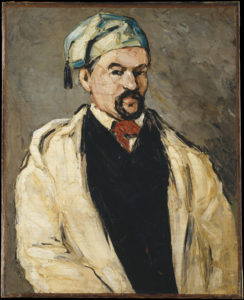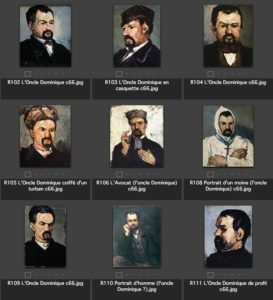R107 – L’homme au bonnet de coton (l’oncle Dominique), vers 1866 (FWN412)
Pavel Machotka
(Cliquer sur l’image pour l’agrandir)
A series of portraits, as against a single one, puts a different kind of burden on the painter: while it helps him master the likeness, it also runs the risk of repetition. Cézanne therefore has his uncle, presumably a good-natured man, don and doff various cloaks and hats, play monk or judge or sportsman, and the series that results varies in color, size, and pose. What is invariable about it is its alla prima surface; it is done with the palette knife with no trace of corrections.
Cézanne’s handling of the knife is self-assured. With it he forms eyebrows, eyes, nose, beard, hands, and tunic, and models the face and hair with well-placed dabs for the highlights and shadows. In the smaller pictures we have only the well-done head to admire, while in the larger ones we can appreciate the composition, which is as calmly balanced as the touch is forceful. In L’Homme au bonnet de coton, one of the two largest pictures in the series, Cézanne retains all of the spontaneity of the touches of the small versions, and achieves this, I think, by keeping the color scheme and composition simple. With a black and white color foundation, and a neutral grey ground, he sets a red cravatte against a complementary green bonnet, and then balances the composition by letting the left inclination of the bonnet weigh against the rightward sweep of the white coat. With the Uncle Dominique series Cézanne reveals that he could integrate a composition even when working at passionate speed, and that when working with the knife, he would know when to stop.
Source: Machotka, Cézanne: the Eye and the Mind.
Autres portraits de l’oncle Dominique :



